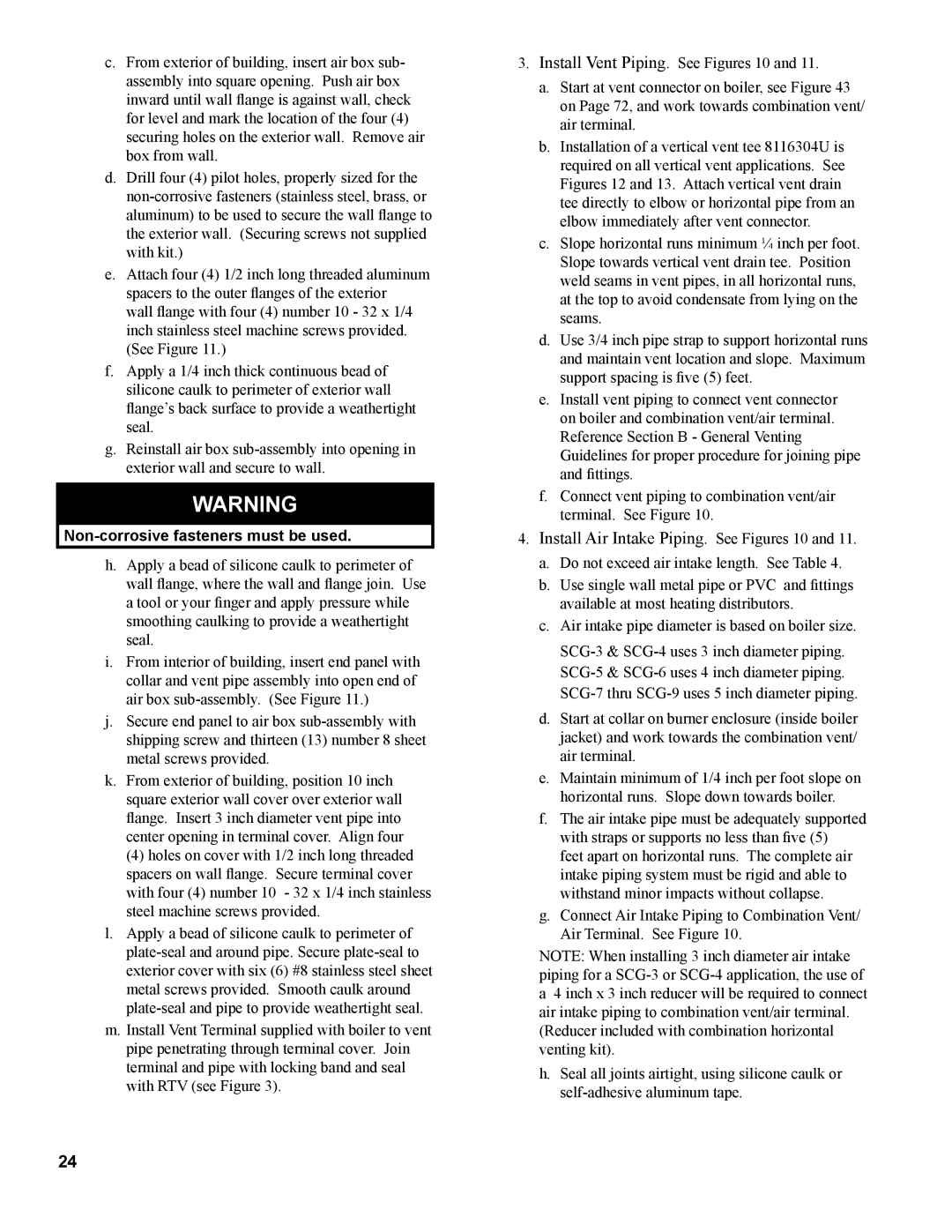
c.From exterior of building, insert air box sub- assembly into square opening. Push air box inward until wall flange is against wall, check for level and mark the location of the four (4) securing holes on the exterior wall. Remove air box from wall.
d.Drill four (4) pilot holes, properly sized for the
e.Attach four (4) 1/2 inch long threaded aluminum spacers to the outer flanges of the exterior wall flange with four (4) number 10 - 32 x 1/4 inch stainless steel machine screws provided. (See Figure 11.)
f.Apply a 1/4 inch thick continuous bead of silicone caulk to perimeter of exterior wall flange’s back surface to provide a weathertight seal.
g.Reinstall air box
WARNING
Non-corrosive fasteners must be used.
h.Apply a bead of silicone caulk to perimeter of wall flange, where the wall and flange join. Use a tool or your finger and apply pressure while smoothing caulking to provide a weathertight seal.
i.From interior of building, insert end panel with collar and vent pipe assembly into open end of air box
j.Secure end panel to air box
k.From exterior of building, position 10 inch square exterior wall cover over exterior wall flange. Insert 3 inch diameter vent pipe into center opening in terminal cover. Align four
(4) holes on cover with 1/2 inch long threaded spacers on wall flange. Secure terminal cover with four (4) number 10 - 32 x 1/4 inch stainless steel machine screws provided.
l.Apply a bead of silicone caulk to perimeter of
m.Install Vent Terminal supplied with boiler to vent pipe penetrating through terminal cover. Join terminal and pipe with locking band and seal with RTV (see Figure 3).
3.Install Vent Piping. See Figures 10 and 11.
a.Start at vent connector on boiler, see Figure 43 on Page 72, and work towards combination vent/ air terminal.
b.Installation of a vertical vent tee 8116304U is required on all vertical vent applications. See Figures 12 and 13. Attach vertical vent drain tee directly to elbow or horizontal pipe from an elbow immediately after vent connector.
c.Slope horizontal runs minimum ¼ inch per foot. Slope towards vertical vent drain tee. Position weld seams in vent pipes, in all horizontal runs, at the top to avoid condensate from lying on the seams.
d.Use 3/4 inch pipe strap to support horizontal runs and maintain vent location and slope. Maximum support spacing is five (5) feet.
e.Install vent piping to connect vent connector on boiler and combination vent/air terminal. Reference Section B - General Venting Guidelines for proper procedure for joining pipe and fittings.
f.Connect vent piping to combination vent/air terminal. See Figure 10.
4.Install Air Intake Piping. See Figures 10 and 11.
a.Do not exceed air intake length. See Table 4.
b.Use single wall metal pipe or PVC and fittings available at most heating distributors.
c.Air intake pipe diameter is based on boiler size.
d.Start at collar on burner enclosure (inside boiler jacket) and work towards the combination vent/ air terminal.
e.Maintain minimum of 1/4 inch per foot slope on horizontal runs. Slope down towards boiler.
f.The air intake pipe must be adequately supported with straps or supports no less than five (5) feet apart on horizontal runs. The complete air intake piping system must be rigid and able to withstand minor impacts without collapse.
g.Connect Air Intake Piping to Combination Vent/ Air Terminal. See Figure 10.
NOTE: When installing 3 inch diameter air intake piping for a
a4 inch x 3 inch reducer will be required to connect air intake piping to combination vent/air terminal. (Reducer included with combination horizontal venting kit).
h.Seal all joints airtight, using silicone caulk or
24
